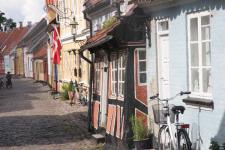 |
|
Enlarge photo |
To commemorate the Smithsonian Presents Travels with Rick Steves magazine — now on sale online, and at newsstands nationwide — Rick is blogging about the 20 top destinations featured in that issue. One of those destinations is Bruges, Belgium.
Chocolate, beer, canalside bike rides, French fries, carillon concerts…Bruges is an amazing little tourist town. While you might get discouraged as you shuffle through its sights along with hordes of tourists, it’s worth it. The town entertains with a unique knack for excellence and an infectious passion for good living.
Locals swear by their personal favorite chocolatier. They know that when the weather’s too hot, the chocolate-makers close down. The people of Bruges buy their chocolate with a concern for freshness like a muffin-eater does in the USA. Yesterday’s chocolate just won’t do.
Pubs are not just pubs. They are destinations…as the annual visits of many American beer aficionados attest. Pubs in the ye olde center — places you’d think would be overrun by tourists — are the proud domain of locals, who find the fact that monasteries have historically brewed the finest Belgian beers perfectly in line with their personal theology.
French fries (called Vlaamse frites, or “Flemish fries,” for the region of Flanders, in which Bruges lies) are another guilty local pleasure. One time a Bruges chef took me into the kitchen to witness the double-deep-frying process required to make a fry up to Flemish standards. His nervous, giggly reveal reminded me of the kid who showed me my first dirty magazine at the Y back when I was a grade-schooler. He’d pick up a single fat fry, ready for its second hot-oil bath. Holding it at the bottom, he made it wobble, as if playfully sharing a centerfold.
Bruges offers the best carillon concert I’ve found in Europe (normally June-Sept Mon, Wed, and Sat at 21:00; Oct-May Wed and Sun at 14:15). The city puts out benches in the courtyard below the City Hall bell tower. You can hear the tunes ringing out from the tower’s bells anywhere in the town center. But to sit in that courtyard, looking up at the rustic brick tower and hearing the performance, is a ritual for locals…and it just seems right.
Seated there one evening, I gaze up at the lofty tower. Like a kid checks in with his mom and dad before going down a long slide at the playground, the carillonneur pops his head out a window and waves. Then he disappears and begins hammering — literally hammering, as a carillon keyboard looks like the keyboard foot pedals of a big organ, yet are played by the little-finger sides of clenched fists.
After the concert, we clap, and he appears again — tiny head popping out the little window to happily catch our applause. The crowd dissipates. I wait at the base of the tower to personally thank the carillonneur. A few minutes later, he’s at street level, in his overcoat, looking like any passerby. I shake his hand and find myself gripping a freakishly wide little finger. A lifetime of pounding the carillon has left him with a callus that more then doubled the width of his pinky. Just one more artist in the city of Bruges.

